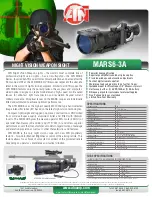
7
O
perating the EQ1 mount
(for all models)
The EQ1 mount has controls for both conventional altitude (up-down) and
azimuth (left-right) directions of motion. These two adjustments are
suggested for large direction changes and for terrestrial viewing. Use the
large knurled knob located underneath for azimuth adjustments. Loosen the
knob and rotate the mount head around the azimuth axis. Use the altitude
adjustment T-bolts for altitude adjustments (Fig.e).
In addition, this mount has Right Ascension (hour angle) and declination
direction controls for polar-aligned astronomical observing. Loosen the lock
knobs to make large direction changes. Use the control cables for fine
adjustment after the lock knobs have both been locked (Fig.f). An additional
scale is included for the altitude axis. This allows polar alignment for your
local latitude. (Fig.g)
Fig.e
Altitude
adjustment
(up-down)
Azimuth
adjustment
(left-right)
0
10
20
30
40
50
60
70
80
90
Fig.g
Fig.i
unlock
Fig.h
P
olar Alignment
(for all models)
Fig.f
Dec. fine
adjustment
R.A. fine
adjustment
R.A. scale
Dec. lock knob
Dec. scale
In order for your telescope to track objects in the sky you have to align
your mount. This means tilting the head over so that it points to the
North (or South) celestial pole. For people in the Northern
Hemisphere this is rather easy as the bright star Polaris is very near
the North Celestial Pole. For casual observing, rough polar alignment
is adequate. Make sure your equatorial mount is level and the red dot
finder is aligned with the telescope before beginning.
Setting the latitude
Remove the telescope tube and the counterweights from the mount.
Find the latitude and time zone of your current location. A road atlas
or GPS unit is useful for your local geographic coordinates. Now look
at the side of your mount head, there you will see a scale running
from 0-90 degrees (Fig.i). Unlock the hinge of the mount by gently
pulling on the lock lever counter-clockwise. At the bottom of the head
is a screw that pushes on a tongue under the hinge, changing the
angle. Spin this until your latitude is shown on the scale by the
indicator pin, then lock the hinge (Fig.h).
Finding Polaris
Polaris, the "Pole Star" is less than one degree from the North
Celestial Pole (NCP). Because it is not exactly at the NCP, Polaris
appears to trace a small circle around it as the Earth rotates. Polaris
is offset from the NCP, toward Cassiopeia and away from the end of
the handle of the Big Dipper (Fig.i).
+
Polaris
Cassiopeia
Little Dipper
Big Dipper
NCP
Alligning your telescope to Polaris
Unlock the DEC lock knob and rotate the telescope tube until the
pointer on the DEC setting circle reads 90˚. Retighten the DEC lock
knob. Move the tripod so that the mount faces north and the R.A. axis
points roughly at Polaris. A hand campass is useful for this step.
Unlock the azimuth adjustment knob located underneath the mount




















